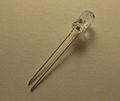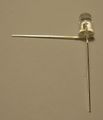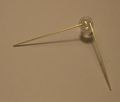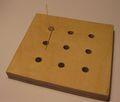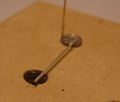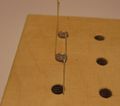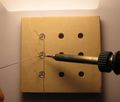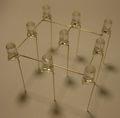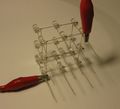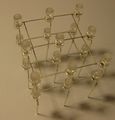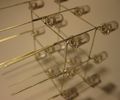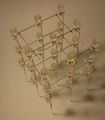LED Cube/Cube Soldering Manual: Unterschied zwischen den Versionen
Marvin (Diskussion | Beiträge) |
Marvin (Diskussion | Beiträge) Keine Bearbeitungszusammenfassung |
||
| Zeile 60: | Zeile 60: | ||
File:cs3-013.jpeg | File:cs3-013.jpeg | ||
</gallery> | </gallery> | ||
==Assembling the Planes== | |||
We have nearly finished preparing the LEDs. It is now time to assemble the planes. To get to the plane, we will first assemble a single row. A very handy tool for this is a plate with holes drilled into it where the LEDs belong. Just insert the first LED into the top left corner of the plate, with the legs oriented like this: | |||
<gallery> | <gallery> | ||
File:cs3-014.jpeg | File:cs3-014.jpeg | ||
</gallery> | |||
<gallery> | |||
File:cs3-015.jpeg | File:cs3-015.jpeg | ||
File:cs3-016.jpeg | File:cs3-016.jpeg | ||
Version vom 17. April 2012, 20:49 Uhr
Vorlage:LED Cube Series This page of the LED Cube Series will guide you through the process of building the Cube structure of the LED Cube. Building this structure is not really hard, but it may be a bit frustrating if the wires do not want like you. This is normal and your first cube will most probably not look perfect. However, this is a beginner workshop, so there will be much to learn.
LED preparation
How this first step will look somewhat depends on your LEDs. For now we will only clear LED bodies with one color:
Thus, if you have matt LEDs, you do not have to care about this step.
The clear see-through LEDs have a big advantage over the matt ones: You can see through them and thus the illusion of free hanging lights is much better. However, they also have a notable disadvantage: They have a very small cone of light coming out at the top. This makes it nearly impossible to look into them from above, they nearly don't shine from the side and LEDs from below will also illuminate LEDs above them. A very good workaround at this point is to grab a sheet of fine sand paper and to sand the top surface of the LED. Here you can see the difference:
Repeat this step with all LEDs, if you want. Try not to bend the legs to much, as this will on one hand stress them and on the other hand make your cube look less regular. (Of course, you may want such a cube - that is your decision. ;) .)
LED Bending
In the second step we have to bend the legs of the LEDs so you can assemble them without much mechanical stress on the wires. Be careful with the next steps - they are deciding how your cube looks like. Also, try to bend the wires correct the first time and not wiggle much on them, they tend to break off if you overdo it.
Short Leg
First, take one LED:
Hold it upside down and make sure that the longer of the two legs is the left one, the shorter the right one. Then bend the shorter 90 degrees towards you. The result should look like this:
Repeat this step for all LEDs check twice that you bent the correct leg. If you are using the wrong ones, the LED will not work.
Long Leg
Again for all LEDs repeat the following steps: Take one LED and hold it like you did last time. This time, of course, the short leg is already bent to you. The long leg on the left side now is to be bent 90 degres to the left. The result will look like this:
Now take a pair of (flat nose) pliers and grab the same leg directly where the LED body ends:
And bend it back up. The long leg is now going into the same direction as prior to this step, but shifted away from the LED:
Don't forget to repeat this step for every LED:
Assembling the Planes
We have nearly finished preparing the LEDs. It is now time to assemble the planes. To get to the plane, we will first assemble a single row. A very handy tool for this is a plate with holes drilled into it where the LEDs belong. Just insert the first LED into the top left corner of the plate, with the legs oriented like this:
